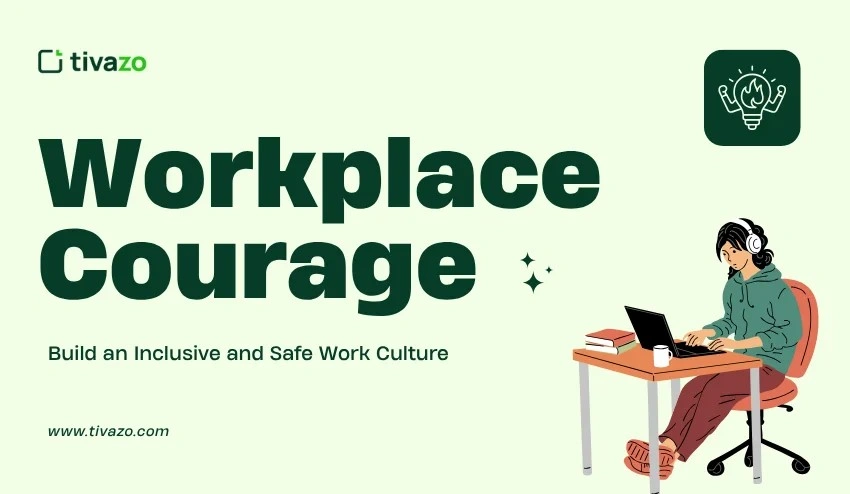In the fast-moving and competitive world we live in, workplace culture can make or break a company. However, creating a workplace that is inclusive, supportive, and innovative is difficult. One of the essential ingredients to develop this kind of workplace is workplace courage; the ability to act, to speak up, despite one’s fear.
It is this courage that encourages employees to express their ideas without fear of rejection, challenge the status quo, or even advocate against discrimination. When workplace courage is present in an organization, inclusivity can prosper, innovation can grow, and employee satisfaction can increase.
In this blog post, we will explore what workplace courage is, why it is important for an inclusive culture, and we will provide five actionable steps organizations can take to encourage it, which will lead to the organization’s long-term success.
Key Highlights:
- What is Workplace Courage
- Proven Steps to Cultivate Workplace Courage
- Environment That Encourages Risk-Taking
- How to Deal with Setbacks and Failures
- Impact of Courageous Leadership on Team Innovation
What is Workplace Courage?
At its most fundamental level, workplace courage is acting, speaking, and making decisions beyond your fear, typically by breaking some rule or convention. In workplace courage, an employee challenges the standard way of thinking, even for themselves, to address a difficult issue or speak up for what is right.
Workplace courage can take many forms:
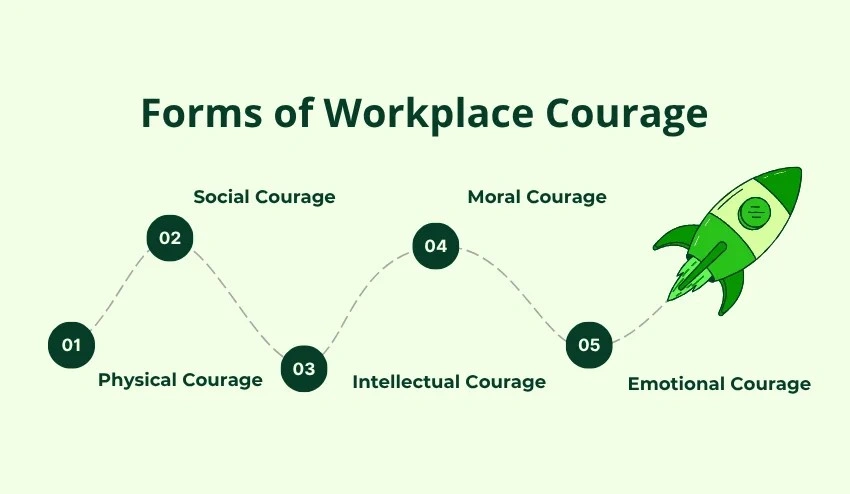
- Physical Courage: Taking action to assist or protect someone else in the workplace.
- Social Courage: Engaging with others based on your beliefs, despite the fear of social exclusion or ostracization.
- Intellectual Courage: Questioning the status quo, becoming comfortable in a new or transformative environment, or making a mistake, and being open to rethinking.
- Moral Courage: Taking a stand for what is right, even when it is unpopular.
- Emotional Courage: Admitting vulnerability, sharing emotions, and dealing with aspects of yourself that may be challenging.
These different forms of workplace courage are all important aspects of psychologically safe and inclusive workplaces.
The Link Between Courage and Inclusion
Inclusion is more than simply hiring diverse talent; it’s about building a psychologically safe space where everyone feels valued and respected. Courage at work is important in this process because it helps employees feel safe to share their perspective, question the norm, and take action on behalf of themselves and others.
In other words, courage is the driver of inclusivity, which, in turn, influences higher engagement, creativity, and retention. When you create an atmosphere of courage at work, you are helping to include individuals’ whole selves at work, which leads to higher job satisfaction and a better company culture.
5 Proven Steps to Cultivate Workplace Courage
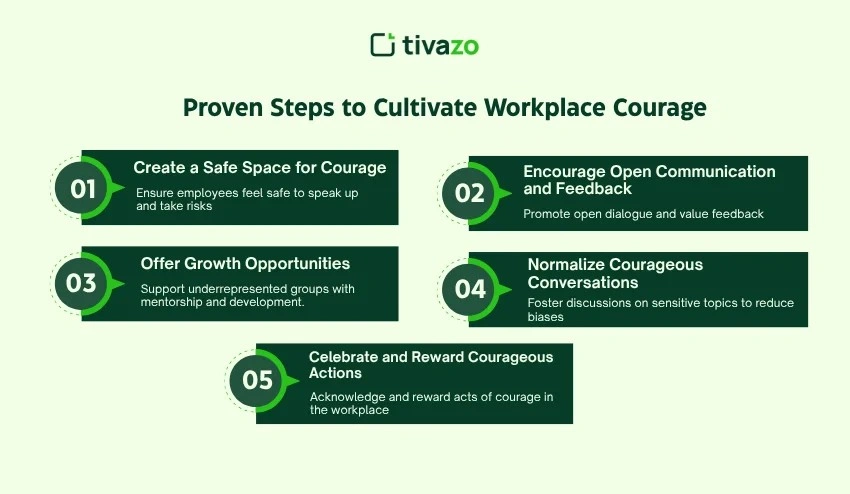
Step 1: Create a Safe Space for Workplace Courage
To create the conditions for workplace courage, employees must first feel a sense of psychological safety. Workers can’t speak up if they feel their ideas and feedback will be disrespected, or worse, made a mockery of. When workers feel safe to take a risk-whether that is speaking in a meeting or questioning a long-established method, they will be more inclined to engage and lean in.
- Model vulnerability by sharing your own struggles and failures.
- Show employees it is safe to take a risk without punishment.
- Encourage a willingness to be open and admit when you do not have the answer.
Step 2: Encourage Open Communication and Constructive Feedback
Communication is the key to workplace courage. Employees want to feel their voices matter and their feedback has value. Having a communication process ensures psychological safety is threaded throughout encounters so employees are not holding back, whether it is offering feedback, generating new ideas, exploring difficult topics, or asking for help.
- Create a cadence of check-ins and feedback loops to facilitate open communication.
- Encourage open forum meetings where teams can engage in dialogue about ideas, struggles, and successes.
- When providing feedback, ensure all cues are constructive-aimed at improvement.
Step 3: Offer Growth Opportunities for Diverse Voices
If we’re going to embrace true inclusivity, we must provide opportunities for underrepresented voices. This may involve providing mentorship for employees, creating safe spaces for marginalized communities, and providing employees who are from underrepresented backgrounds with opportunities to take advantage of the same resources available for leadership development as all other employees.
- Offer mentorship or sponsorship programs for underrepresented groups.
- Create leadership development opportunities that actively promote diverse talent.
- Ensure that all employees, regardless of background, have access to the same resources as everyone else for promotion opportunities.
Step 4: Normalize Courageous Conversations
If you’re going to explore sensitive topics, such as race, gender equality, and diversity, it’s important to engage in courageous conversations. These conversations help employees lean in and understand each other’s perspectives, as well as reduce biases and remove barriers, while creating a culture of acceptance and respect.
- Incorporate courageous dialogue sessions as part of a regular team meeting or quarterly company meeting.
- Normalize conversations about diversity, inclusion, and other sensitive social issues.
- Create a safe space for employees to share their experiences with bias, discrimination, and other barriers.
Step 5: Celebrate and Reward Courageous Actions
Acknowledging and rewarding acts of courageous behavior reinforces the types of behavior you want to see in your organization. Whether it’s to speak up during a company meeting, challenge a discriminatory practice, or advocate for a colleague, courageous acts deserve to be rewarded in some fashion.
- Establish dimension-specific recognition systems for courageous behaviors.
- Reward employees who take courageous actions that support the company’s values of Randall Courage and inclusion.
- Recognize and honor employees who act courageously in company meetings or internal communications.
Overcoming Common Fears in the Workplace
Recognizing the Fear
Many employees worry about being judged, rejected, tasks not succeeding, etc. Many fears prevent employees from engaging in speaking up or trying out something new. It is the responsibility of leadership to both recognize the fear employees have and create an environment where employees feel comfortable taking risks. Acknowledging fear presence helps facilitate trust and ultimately increases psychological comfort in employees. Employees need to know it is alright to be fearful fear is their feelings; acknowledging fears is the first step in helping employees address their fears.
Overcoming the Fear
To help employees overcome fear, you must equip them with the skills and support to face challenges directly. You can reinforce employees by mentoring or coaching them in managing their fear. You can change thinking about failure as learning to alleviate worry, and gradually raise the level of risk they take to build confidence. With consistent support and positive reinforcement, employees will feel empowered and driven to engage in more courageous behaviors.
The Role of Feedback in Building Workplace Courage
Feedback is one of the most powerful ways to help an employee build their self-motivation and courage. Constructive and caring feedback will not only help employees improve in certain areas but will also reinforce risk-taking, learning from failure, and attempting things outside their comfort zone. Taking focus and attention towards not being afraid of failing but noticing opportunities to learn reframes mental well-being, and an employee’s bias and learning will be greater. Feedback that is framed as a learning opportunity will only serve to encourage the employee’s courage to accept risk, and learn through skilled risk-taking and error.
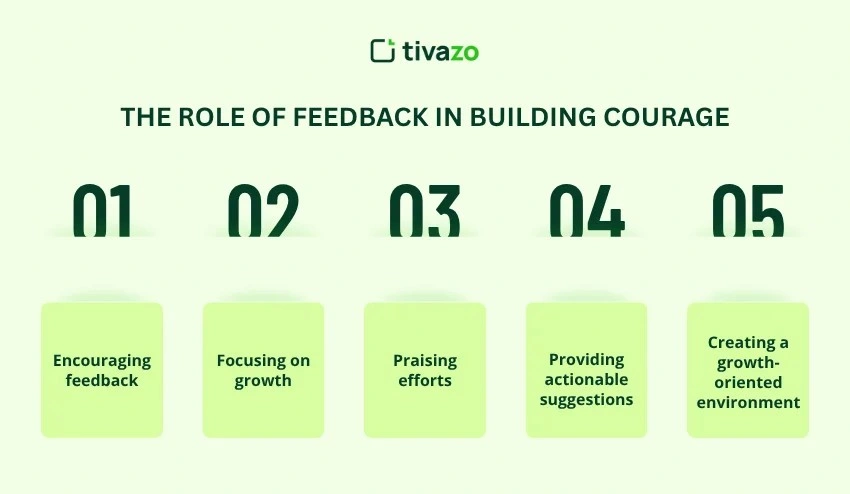
- Encouraging feedback: Share both positives and areas for growth to offer a balanced view.
- Focusing on growth: Provide constructive feedback that demonstrates there are learning opportunities and not only mistakes.
- Praising efforts: Be sure to notice and appreciate people when they take a chance or a risk to try something new, even if they do not know what the outcome will be.
- Providing actionable suggestions: Make suggestions that support employees using what they have learned to strive for improvement.
- Creating a growth-oriented environment: Build a culture where feedback is a positive way to contribute to personal growth.
Creating an Environment That Encourages Risk-Taking
Risk-taking is essential for creativity and innovation. In fact, when employees know it is acceptable to take risks or chances, they are empowered to be continuously improving, creative, and innovative. Organizations pursuing a culture where risk-taking is paramount will encourage creativity, innovation, and opportunities to move outside of comfort zones to try something new. The more chances the organization provides employees to try something new, the more likely it will have a positive effect on the organization’s success.
- Valuing innovation: Recognizing risks will create new ideas and solutions.
- Creating an open environment: Provide an environment where employees know it is safe to try new or different things.
- Support risks based on calculations: Provide equity, resources, or mentoring opportunities that allow the employee to take risks without the fear of failure.
- Celebrating bold moves: Recognize and honor employees who engage in acts of bravery that contribute to innovation or positive change.
How to Deal with Setbacks and Failures in a Courageous Workplace
Instead of fearing failure, embrace it. In a courageous workplace, failure is seen as an essential growth experience, not a failure. Although failures create lessons, which can influence both personal development and business innovation. When team members are engaged in taking risks and pushing boundaries, there are inevitably challenges as well; this is where the real growth happens. If the workplace culture reinforces the idea that failing is about gaining knowledge, the organization can help build hope and a growth mindset. This effort can help people rebound and grow stronger, as well as create an environment where team members feel safe to try new methods of experimentation and innovation without the heavy notion of failing.
How Courageous Teams Drive Innovation and Success
Leveraging Workplace Courage for Collective Innovation
Courage is not only an individual phenomenon; it impacts team dynamics and success. When teams behave courageously as a team, they are more likely to be open to collaboration, sharing ideas, and solving problems. When teams are courageous, they challenge the status quo, engage in difficult discussions and ask hard questions, and try something new, which leads to a culture that builds creativity and innovation. Collaboration leads to better performance of teams, which supports overall company success. When workplace courage is a value for teams, team members show enhanced resilience, share responsibilities to work through complexity as a team, and work for long-term success.
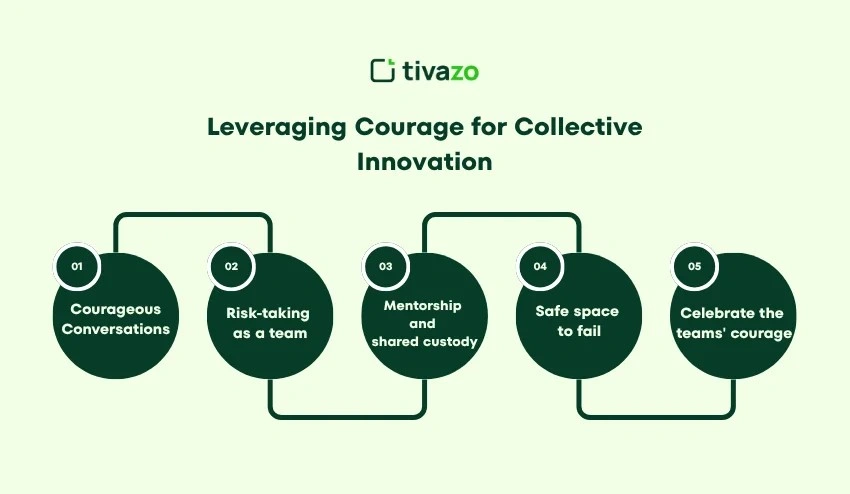
- Courageous Conversations: Foster an open, honest forum for discussions where all ideas are welcome, resulting in more diverse and creative solutions.
- Risk-taking as a team: Encourage joint risk-taking opportunities; it should not always be about avoiding failure, but about what we learn and can improve on.
- Mentorship and shared custody: Ensure there is a collaborative responsibility for the problem at hand.
- Safe space to fail: Create a culture where mistakes and flaws are considered learning experiences rather than liability, not only for the team, but higher in the organization too. This allows teams the ability to experiment and innovate.
- Celebrate the teams’ courage: Recognition of workplace courage reinforces the importance of teamwork at all levels of the organization.
The Impact of Courageous Leadership on Team Innovation
Brave leadership is a major factor that helps create an atmosphere where teams feel encouraged to try things and innovate. When leaders model bravery in action, they set the tone for their teams. This can mean standing behind a team member’s idea that is unconventional, encouraging a team to take a calculated risk, or embracing failure as part of trying something new. All symbolize that leaders engender a feeling of belief in their team members. Encouraging each individual to take a risk and step out of their comfort zone while also being innovative demonstrates to the team that it can be done.
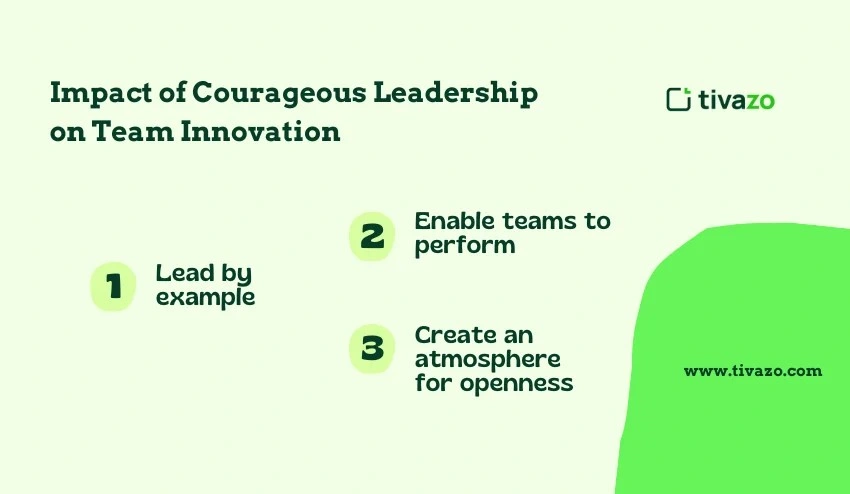
- Lead by example: Lead by example and display your bravery either in taking a risk, providing constructive feedback, or backing a new idea.
- Enable teams to perform: Allow teams to make decisions and own the project and the processes to promote trust and accountability.
- Create an atmosphere for openness: Develop an atmosphere where feedback is expected so teams can learn and grow.
Conclusion: The Long-Term Benefits of Workplace Courage
The positive impact of workplace courage affects everyone. Organizations that support courage enable their employees to be engaged, creative, and inclusive leaders. Employees who feel capable of taking risks and taking action will likely remain engaged, be creative thinkers, and lead their organizations in positive change.
Organizations can create a culture of workplace courage by supporting the five steps discussed above, which focus on developing all employees for both their individual lifetime success and the long-term financial success of the organization.
